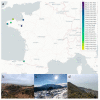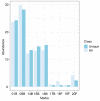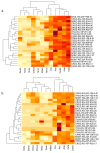Rhizocarpon geographicum Lichen Discloses a Highly Diversified Microbiota Carrying Antibiotic Resistance and Persistent Organic Pollutant Tolerance
- PMID: 36144461
- PMCID: PMC9503503
- DOI: 10.3390/microorganisms10091859
Rhizocarpon geographicum Lichen Discloses a Highly Diversified Microbiota Carrying Antibiotic Resistance and Persistent Organic Pollutant Tolerance
Abstract
As rock inhabitants, lichens are exposed to extreme and fluctuating abiotic conditions associated with poor sources of nutriments. These extreme conditions confer to lichens the unique ability to develop protective mechanisms. Consequently, lichen-associated microbes disclose highly versatile lifestyles and ecological plasticity, enabling them to withstand extreme environments. Because of their ability to grow in poor and extreme habitats, bacteria associated with lichens can tolerate a wide range of pollutants, and they are known to produce antimicrobial compounds. In addition, lichen-associated bacteria have been described to harbor ecological functions crucial for the evolution of the lichen holobiont. Nevertheless, the ecological features of lichen-associated microbes are still underestimated. To explore the untapped ecological diversity of lichen-associated bacteria, we adopted a novel culturomic approach on the crustose lichen Rhizocarpon geographicum. We sampled R. geographicum in French habitats exposed to oil spills, and we combined nine culturing methods with 16S rRNA sequencing to capture the greatest bacterial diversity. A deep functional analysis of the lichen-associated bacterial collection showed the presence of a set of bacterial strains resistant to a wide range of antibiotics and displaying tolerance to Persistent Organic Pollutants (POPs). Our study is a starting point to explore the ecological features of the lichen microbiota.
Keywords: antibiotic resistance; culturomics; holobiont; lichen microbiome.
Conflict of interest statement
The authors declare no conflict of interest.
Figures




Similar articles
-
Microbial community associated with the crustose lichen Rhizocarpon geographicum L. (DC.) living on oceanic seashore: A large source of diversity revealed by using multiple isolation methods.Environ Microbiol Rep. 2022 Dec;14(6):856-872. doi: 10.1111/1758-2229.13105. Epub 2022 Jul 20. Environ Microbiol Rep. 2022. PMID: 35860838 Free PMC article.
-
Microbial metacommunities in the lichen-rock habitat.Environ Microbiol Rep. 2011 Aug;3(4):434-42. doi: 10.1111/j.1758-2229.2010.00206.x. Epub 2010 Aug 19. Environ Microbiol Rep. 2011. PMID: 23761305
-
Predicting the distributional range shifts of Rhizocarpon geographicum (L.) DC. in Indian Himalayan Region under future climate scenarios.Environ Sci Pollut Res Int. 2022 Sep;29(41):61579-61593. doi: 10.1007/s11356-021-15624-5. Epub 2021 Aug 5. Environ Sci Pollut Res Int. 2022. PMID: 34351582
-
The Lichens' Microbiota, Still a Mystery?Front Microbiol. 2021 Mar 30;12:623839. doi: 10.3389/fmicb.2021.623839. eCollection 2021. Front Microbiol. 2021. PMID: 33859626 Free PMC article. Review.
-
Chronicle of Research into Lichen-Associated Bacteria.Microorganisms. 2022 Oct 26;10(11):2111. doi: 10.3390/microorganisms10112111. Microorganisms. 2022. PMID: 36363703 Free PMC article. Review.
References
Grants and funding
LinkOut - more resources
Full Text Sources
Research Materials

